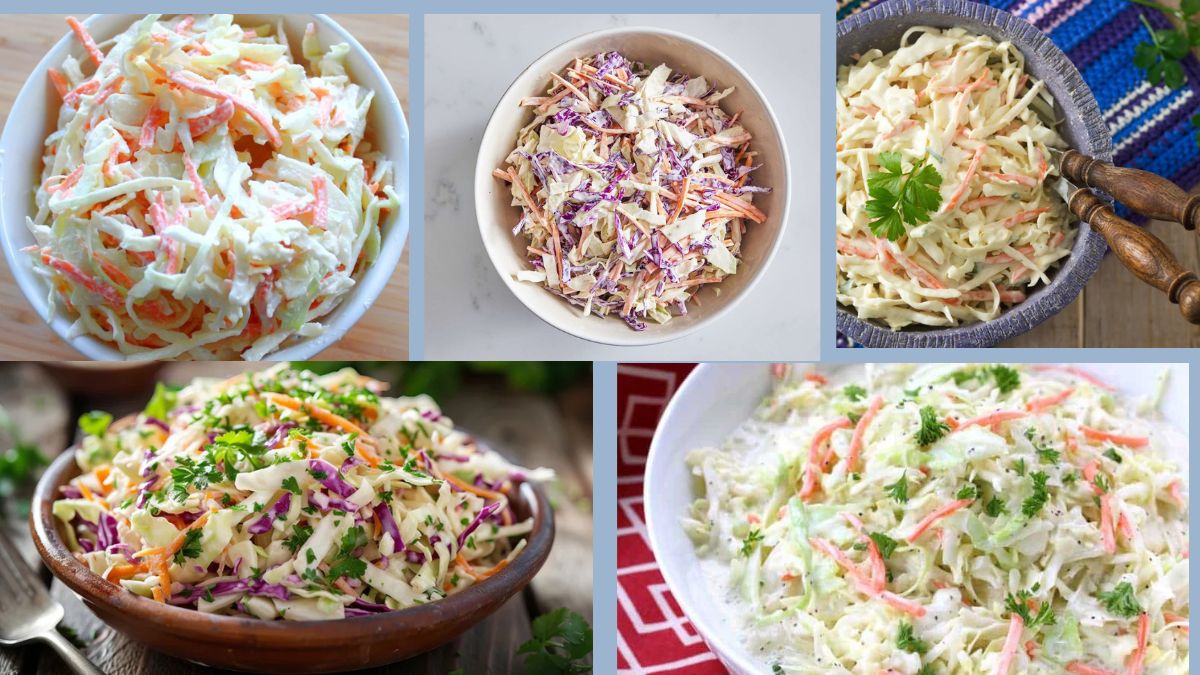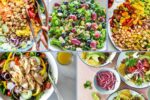Coleslaw—a simple mix of shredded cabbage, carrots, and dressing—might not seem like a global phenomenon at first glance. But dig a little deeper, and you’ll discover that this humble side dish has become a beloved staple in countries around the world.
So, the big question is:
Which country eats the most coleslaw in the world?
The answer is clear: The United States of America.
From backyard barbecues to fast-food chains, school cafeterias to holiday dinners, coleslaw is deeply woven into American food culture. But its popularity extends far beyond the U.S., with countries like the United Kingdom, Australia, Germany, and South Africa embracing their own styles of this crunchy salad—often in vegetarian and even vegan forms.
In this article, we’ll explore:
- The history and evolution of coleslaw
- Its traditional and modern vegetarian ingredients
- The countries that consume the most coleslaw today
- Why it remains a favorite in vegetarian and plant-based diets
- Unique coleslaw variations around the world
Let’s dig into the creamy, tangy world of coleslaw—without a trace of meat.
What Is Coleslaw? A Brief History
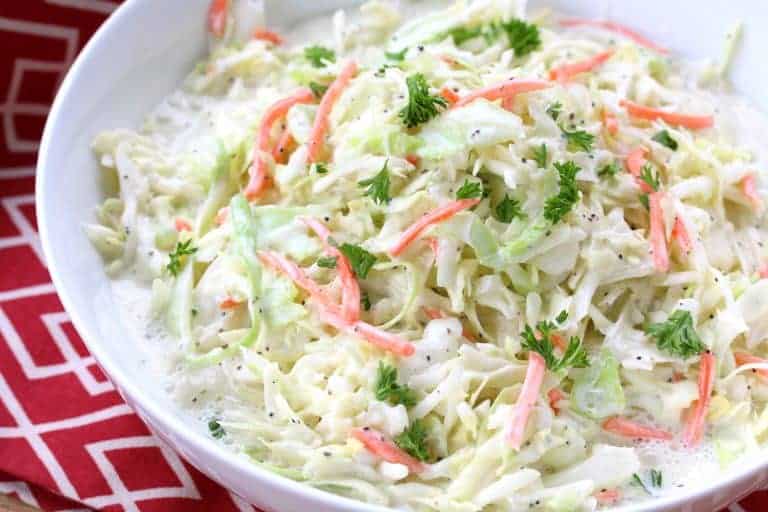
The word “coleslaw” comes from the Dutch term “koolsla,” meaning “cabbage salad.” Dutch settlers are believed to have brought this dish to America in the 18th century. The original recipe was simple: shredded cabbage dressed with vinegar and oil.
Today, coleslaw typically consists of:
- Shredded green or red cabbage
- Grated or julienned carrots
- Creamy dressing (usually mayo-based) or vinaigrette
- Seasonings like sugar, mustard, celery seed, or pepper
- Optional mix-ins like apple, raisins, or herbs
It’s worth noting that traditional coleslaw is vegetarian—it contains no meat, seafood, or poultry. While some modern variations add bacon or ham (especially in the U.S.), the classic version remains a meat-free delight.
Why the United States Eats the Most Coleslaw
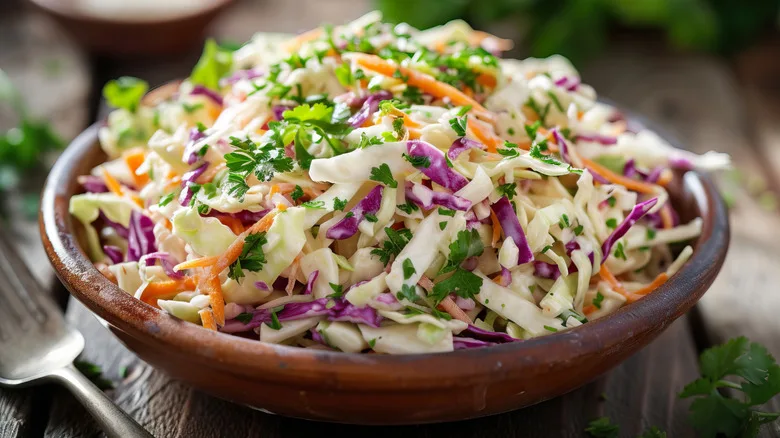
In the U.S., coleslaw is practically a national side dish. It accompanies everything from fried foods and sandwiches to grilled mains and picnic plates.
Key Reasons for Its Popularity:
- Barbecue culture: Coleslaw is the perfect cooling side for smoky, spicy dishes.
- Convenience: It’s easy to make in bulk and keeps well for hours.
- Fast food influence: Chains like KFC, Chick-fil-A, and Popeyes popularized coleslaw as a go-to side.
- Salad bars and delis: It’s a staple in grocery stores and sandwich shops nationwide.
- Home cooking: Affordable, easy, and made with pantry staples.
Pre-packaged coleslaw mixes are available in almost every American grocery store, often with vegetarian or vegan dressing options.
Other Countries That Love Coleslaw
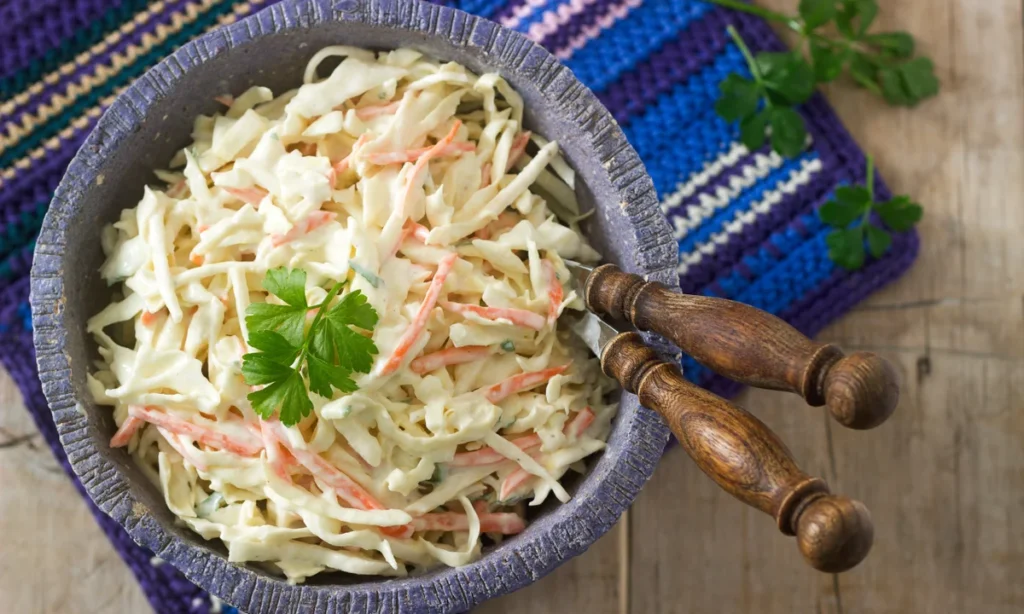
While the U.S. leads the pack, coleslaw has taken root in many other countries—especially those with Western-style dining or colonial influence. Here’s a look at some top contenders:
1. United Kingdom
Coleslaw is extremely popular in the UK and often appears in pub food, sandwiches, and supermarket meal deals.
- The British version often includes onions and mayonnaise, and sometimes cheese.
- Vegetarian coleslaw is common, and many supermarkets offer vegan options.
- It’s served alongside dishes like jacket potatoes, pies, or sandwiches.
2. Australia
Australians enjoy coleslaw at barbecues, cafes, and fast food outlets. It’s particularly popular as a side with grilled veggies or plant-based burgers.
- Australian coleslaw tends to be lighter and sometimes includes beetroot or capsicum (bell pepper).
- Vegan versions using egg-free mayo are gaining popularity.
3. Germany
Though better known for sauerkraut, Germans love their version of coleslaw called “Krautsalat”.
- Usually dressed with vinegar, oil, and caraway seeds, it’s lighter and tangier than American slaw.
- A vegetarian favorite in beer gardens and home kitchens.
- Served as a side with fried potatoes, dumplings, or bread.
4. South Africa
In South African cuisine, coleslaw is often paired with braais (barbecues) and meals like pap and chakalaka.
- Usually mayo-based and includes pineapple or raisins for a sweet twist.
- It’s a standard in vegetarian combo plates, especially during holidays and gatherings.
5. Canada
Canadian coleslaw closely mirrors the American version. It’s commonly found in deli sandwiches, fast food meals, and catered events.
- Vegetarian coleslaw is often paired with poutine, veggie burgers, or baked beans.
- Supermarkets offer classic, creamy, and vinegar-style slaw kits.
Coleslaw’s Place in Vegetarian Diets
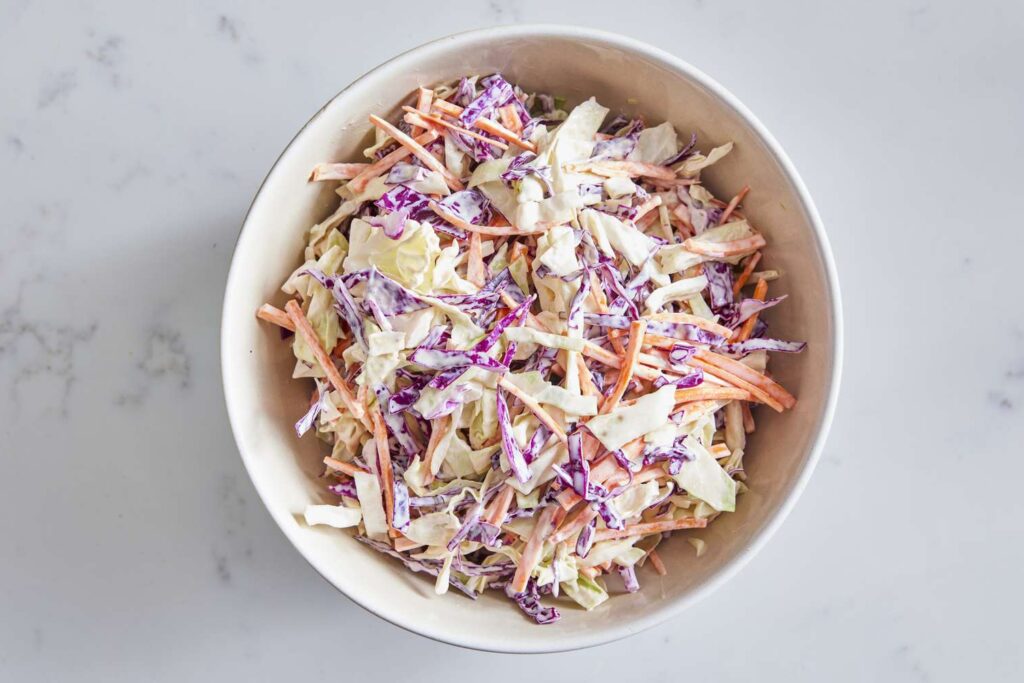
Coleslaw fits seamlessly into vegetarian and even vegan diets, offering a balance of fiber, texture, and flavor.
Why It’s Loved by Vegetarians:
- Naturally meat-free
- Easy to prepare with simple plant-based ingredients
- Customizable – works well with fruits, nuts, seeds, and herbs
- Pairs well with vegetarian mains like falafel, veggie patties, tofu, and plant-based BBQ
Vegetarians often enjoy coleslaw as a side, stuffing, or topping—think slaw-filled pita wraps, tacos, and Buddha bowls.
Popular Vegetarian Coleslaw Variations
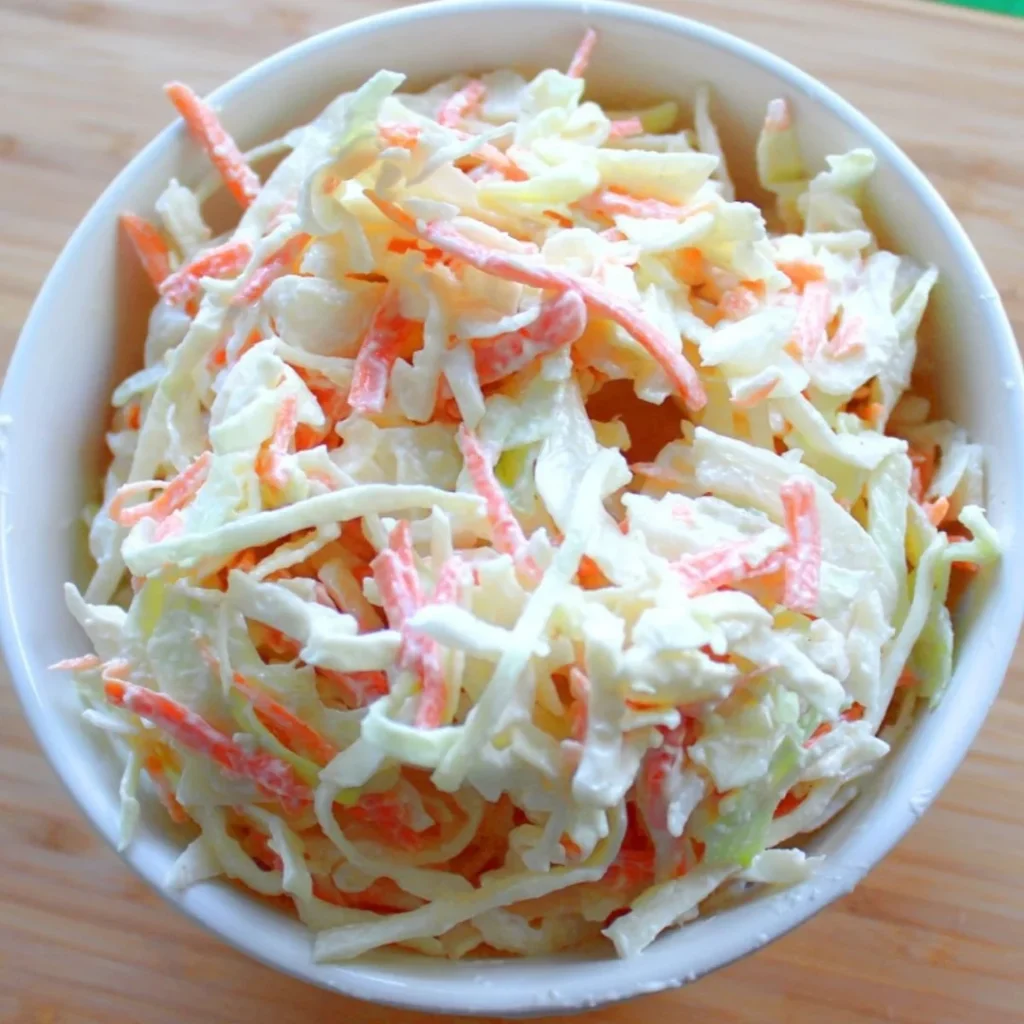
Coleslaw has evolved far beyond cabbage and carrots. Here are some global, vegetarian-friendly versions:
1. Asian-Inspired Slaw
- Includes napa cabbage, shredded carrots, sesame oil, rice vinegar, and green onions.
- Often topped with crushed peanuts or sesame seeds.
- Pairs well with tofu or stir-fried noodles.
2. Apple & Fennel Slaw
- Combines thinly sliced fennel, apples, and cabbage.
- Light vinaigrette dressing (no mayo).
- A crisp, refreshing side for grilled vegetables or veggie roasts.
3. Beetroot Slaw
- Adds shredded beets for earthy flavor and vibrant color.
- Lemon juice and dill enhance its freshness.
- Great with grain bowls or vegetarian schnitzels.
4. Vegan Creamy Slaw
- Uses vegan mayo or cashew-based dressing.
- Keeps all the creaminess without dairy or eggs.
- Ideal for plant-based BBQs or lunchboxes.
Coleslaw in Modern Health Culture
With the rise of clean eating, plant-based diets, and gluten-free lifestyles, coleslaw has made a comeback as a healthy, whole-food salad.
Nutritional Highlights (When Made Right):
- High in fiber – great for digestion
- Rich in vitamins A, C, and K from raw vegetables
- Low in calories (especially with vinegar-based dressings)
- Customizable macros – can add nuts, seeds, or legumes for protein
- Free of meat and refined carbs
By swapping heavy dressings for lighter options and avoiding sugar or preservatives, coleslaw becomes a nutrient-dense, plant-powered dish.
Coleslaw in Meal Kits and Supermarkets
In recent years, coleslaw has exploded in popularity in the convenience food market. In countries like the U.S., UK, and Australia, coleslaw is now found in:
- Pre-shredded slaw kits with included dressings
- Vegan coleslaw tubs in deli aisles
- Salad bars with multiple slaw options
- Ready-to-eat wraps and sandwiches with coleslaw filling
Many brands now offer plant-based and egg-free coleslaw products, catering to vegetarian and vegan customers.
Conclusion: The U.S. Reigns Supreme, But Coleslaw Is a Global Vegetarian Favorite
To answer the question:
Which country eats the most coleslaw in the world?
The United States, thanks to its deep cultural integration, convenience, and food trends.
But coleslaw has become a truly international dish. From Germany’s Krautsalat to the UK’s creamy pub slaw, the vegetarian (and sometimes vegan) versions of coleslaw are more popular than ever.
With its:
- Simple ingredients
- Rich texture and flavor
- Customization potential
- And naturally meat-free profile
Coleslaw proves that you don’t need meat to enjoy a hearty, satisfying, and crowd-pleasing dish.
Whether you’re pairing it with grilled veggies, stuffing it in a sandwich, or serving it alongside plant-based mains, coleslaw is a timeless classic with global appeal.
